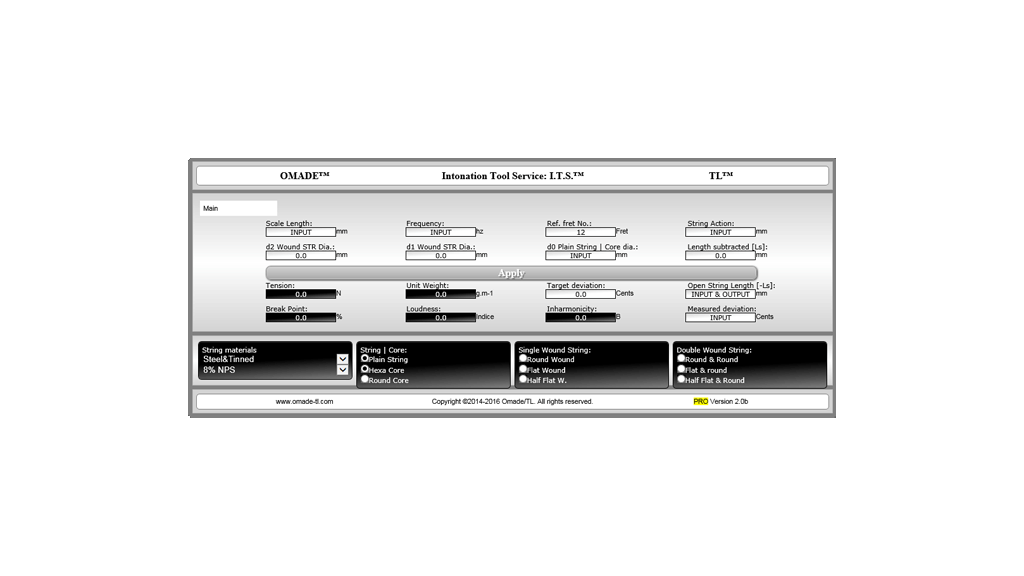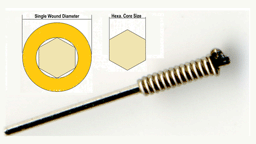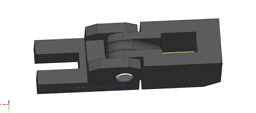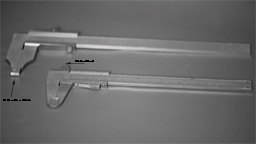Intonation Tool Service: I.T.S™ - Through Internet!

 Zoom in
Zoom in 
The Fastest Way For Ultimate Accuracy
We now offer an Internet access service to the I.T.S.™ software, from home!
The simple fact of changing the strings on a musical instrument drastically affects the intonation parameters, the replaced strings not being ideally identical, they have small defects requiring a verification of the intonation setting during this step .
This service allows you to preserve the precision of your musical instrument when changing strings, or in the hands of a technician, to obtain the best of your musical instrument.
We are the original company offering you the ability to maintain the intonation setting of your musical instrument, and this directly through Internet!
Made in France
Specifications:
Requirement:
- an accurate tuner which shows deviation in cents (you can find one for free on the Internet or ask us to advice you on this matter by E-mail);
- a calliper;
- a thickness gauge (you may also measure string action with a ruler);
- tools for tuning the saddles on the bridge.
Definition:
After calculation with I.T.S.™, and if measured deviation was entered, Open string length become the length for calibration of the Open String Length, and against which the saddle will be placed.
- Scale length input: Distance from the nut to the middle of the 12th fret multiplied by 2 (Also given by the manufacturer).
- Frequency input: Common frequency of the string to settle (E2,A2,D3,G3,B4,D4 commonly used for a 6 string guitar, and entered in Hz).
- Ref. Fret No. input: The fret chosen as a reference for measurement of the frequency deviation in Cents, and for the String action.
- String action input: Shortest distance between the side under the string and the top of the Reference Fret.
- 2nd Wound String Dia. input: Outside diameter of double wound string.
- 1st Wound String Dia. input: Outside diameter of single wound.
- Core Diameter input: Core Size/diameter of plain string (For hexagonal core, use the minimum thickness).
- Length subtracted [Ls} input: Invariable lengths of the Open String (See Calculate [Ls} tab to use this option).
- Tension output: Calculated tension of the string.
- Unit Weight output: Calculated mass per unit length of the string.
- Target Deviation input: Option which allow specific deviation of the frequency at the reference fret chosen earlier. (Leave at '0' for equal temperament).
- Open String L. [-Ls} input | output: The Open String Length or variable length part, which has to be adjusted by setting the bridge saddle.
- BreakPoint output: Estimated percentage before the string break.
- Loudness output: Relative loudness of the string.
- Inharmonicity (Factor B) output: Used to calculate harmonics frequency.
- Measured deviation input: The measured deviation in Cents at the reference fret.
NOTA:Typical core for electric guitar and bass guitar have hexagonal core made of tinned steel -> Choose 'Steel&Tinned' for electric guitar and bass strings core materials, then for wounds, materials used should be indicated on the strings package.

 Zoom in
Zoom in
Calculator for [Ls]
[Ls] is used to subtract invariable length of the Open string length for convenience, to use a shorter calliper.
Scale Length:mm
Fret No./Calliper:Fret. The nth fret counted from the nut, against which measurement will be taken with the calliper, from this fret side to the saddle side on the bridge along the string.
Fret width:mm
Calliper head width:mm. See calliper's head on the picture below.
Saddle length:mm. The length between the side of the saddle (in contact with the calliper), to the end of the open string (See below).
Calculated length Subtracted [Ls]:
(*) This calculator works either, if all entered in mm, or all entered in inches.Open String Length = Calliper measurement + Length subtracted [Ls].
Then,
Calliper measurement = Open String Length - [Ls].
Calliper measurement is the variable length, and Length subtracted are all fixed length along the Open String.
Here is an exemple of an invariable length subtracted measured on a bridge saddle, the calliper will be placed against the left side of the saddle here, for measurement and calibration:

 Zoom in
Zoom in Typical saddle [Ls] value for different kind of bridge:
- Original Floyd Rose® is 0.6 Inches (15.24 mm) ;
- Tune-o-matic type should be 0 Inches (0 mm) ;
- Hardtails should be approximately 0.118 Inches (3 mm)

 Zoom in
Zoom in Typical Core Size
As reference, this is some measured hexagonal core size for single wound string in different string diameter:
| STR DIA: | CORE SIZE: | STR DIA: | CORE SIZE: |
|---|---|---|---|
| 24 | 13 | 0.61 | 0.33 |
| 26 | 14 | 0.66 | 0.356 |
| 28 | 14 | 0.711 | 0.356 |
| 30 | 15 | 0.762 | 0.381 |
| 32 | 15 | 0.813 | 0.381 |
| 34 | 15 | 0.864 | 0.381 |
| 36 | 15 | 0.914 | 0.381 |
| 38 | 15 | 0.965 | 0.381 |
| 42 | 17 | 1.067 | 0.432 |
| 44 | 17 | 1.118 | 0.432 |
| 46 | 17 | 1.168 | 0.432 |
| 49 | 17 | 1.245 | 0.432 |
| 52 | 18 | 1.321 | 0.457 |
| Mills | Mills | MM | MM |
Credits: OMADE™, ITS™, TL™ and their logos are trademarks of Omade TL. OMADE™ is a variant of the registered trademark ΩMADE™ of OMADE TL. Other names may be trademarks of their respective owners.